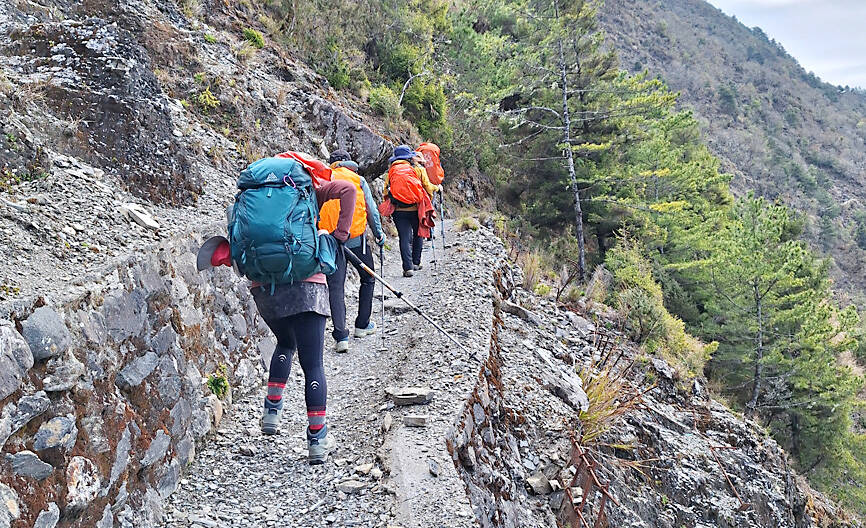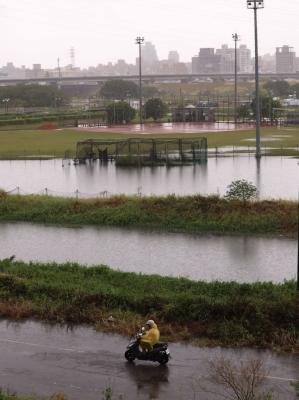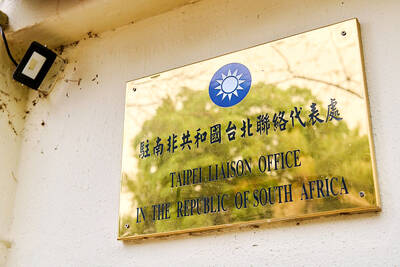Nine incidents, such as altitude sickness, have occurred on Yushan (Jade Mountain, 玉山) in the first half of this month, the Yushan National Park Headquarters said on Sunday, prompting it to issue advice and cautions.
Most areas of the park are at an altitude of 2,500m or higher where temperatures are close to 0°C or below 0°C in the evening due to a recent cold air mass, the headquarters said.
Hikers are advised to adapt their bodies to the high-altitude environment and to do warm-up exercises before the hike, it said.

Photo courtesy of Yushan National Park Headquarters
As the weather changes fast in the mountains, the headquarters recommended that hikers follow the three-layered principle of dressing — breathable and sweat-wicking underwear as the base layer, warm clothing for the middle layer and a waterproof, wind-resistant jacket for the outer layer.
Hikers dressed in three layers while setting out in the early morning can take off the outer or middle layers as they sweat during the hike to prevent the base layer from getting wet, it said.
However, they should put the middle or outer layers on again while walking under the shade of trees or taking a long rest, as chilly winds can cause altitude sickness, the headquarters said.
People with the three highs — high blood pressure, blood sugar and cholesterol — should be careful due to their health conditions and stay warm, as low temperatures could cause vasoconstriction, it said, adding that they should undergo health checks before going on the hike.
Separately, the Nantou County Cian Shan Social Welfare Charitable Foundation on Saturday donated portable altitude chambers (PACs) to the park, which can be used to help relieve symptoms of high-altitude sickness.
Altitude sickness occurs when people move too quickly from low-lying areas to places that are 2,500m or higher above sea level, where oxygen levels in the atmosphere are lower, the headquarters said.
Common symptoms of altitude sickness include headache, nausea, vomiting, fatigue, dizziness and loss of balance, which could turn into life-threatening conditions such as high-altitude cerebral edema or high-altitude pulmonary edema if the person does not descend and seek proper treatment, it said.
A safe and effective way to alleviate altitude sickness is to put the affected person in a PAC and then move them to an altitude that is lower than 2,000m, the headquarters said.
The PAC works by increasing pressure inside the chamber by inflating it from outside, it said.
Boosting air pressure simulates descent, so oxygen levels would rise again and the person would feel better, it added.
The PACs are stored in a red or blue container at 18 locations in the park, including Paiyun Lodge (排雲山莊), Guangao Lodge (觀高山屋, under construction) and other mountain cabins, it said.
They also come with an instruction manual, it added.
Hikers are encouraged to learn how to use the PAC by taking courses at hiking clubs or rescue organizations to equip themselves with the skills to help people with altitude sickness, the headquarters said.

Taipei, New Taipei City, Keelung and Taoyuan would issue a decision at 8pm on whether to cancel work and school tomorrow due to forecasted heavy rain, Keelung Mayor Hsieh Kuo-liang (謝國樑) said today. Hsieh told reporters that absent some pressing reason, the four northern cities would announce the decision jointly at 8pm. Keelung is expected to receive between 300mm and 490mm of rain in the period from 2pm today through 2pm tomorrow, Central Weather Administration data showed. Keelung City Government regulations stipulate that school and work can be canceled if rain totals in mountainous or low-elevation areas are forecast to exceed 350mm in

EVA Airways president Sun Chia-ming (孫嘉明) and other senior executives yesterday bowed in apology over the death of a flight attendant, saying the company has begun improving its health-reporting, review and work coordination mechanisms. “We promise to handle this matter with the utmost responsibility to ensure safer and healthier working conditions for all EVA Air employees,” Sun said. The flight attendant, a woman surnamed Sun (孫), died on Friday last week of undisclosed causes shortly after returning from a work assignment in Milan, Italy, the airline said. Chinese-language media reported that the woman fell ill working on a Taipei-to-Milan flight on Sept. 22

COUNTERMEASURE: Taiwan was to implement controls for 47 tech products bound for South Africa after the latter downgraded and renamed Taipei’s ‘de facto’ offices The Ministry of Foreign Affairs is still reviewing a new agreement proposed by the South African government last month to regulate the status of reciprocal representative offices, Minister of Foreign Affairs Lin Chia-lung (林佳龍) said yesterday. Asked about the latest developments in a year-long controversy over Taiwan’s de facto representative office in South Africa, Lin during a legislative session said that the ministry was consulting with legal experts on the proposed new agreement. While the new proposal offers Taiwan greater flexibility, the ministry does not find it acceptable, Lin said without elaborating. The ministry is still open to resuming retaliatory measures against South

1.4nm WAFERS: While TSMC is gearing up to expand its overseas production, it would also continue to invest in Taiwan, company chairman and CEO C.C. Wei said Taiwan Semiconductor Manufacturing Co (TSMC) has applied for permission to construct a new plant in the Central Taiwan Science Park (中部科學園區), which it would use for the production of new high-speed wafers, the National Science and Technology Council said yesterday. The council, which supervises three major science parks in Taiwan, confirmed that the Central Taiwan Science Park Bureau had received an application on Friday from TSMC, the world’s largest contract chipmaker, to commence work on the new A14 fab. A14 technology, a 1.4 nanometer (nm) process, is designed to drive artificial intelligence transformation by enabling faster computing and greater power